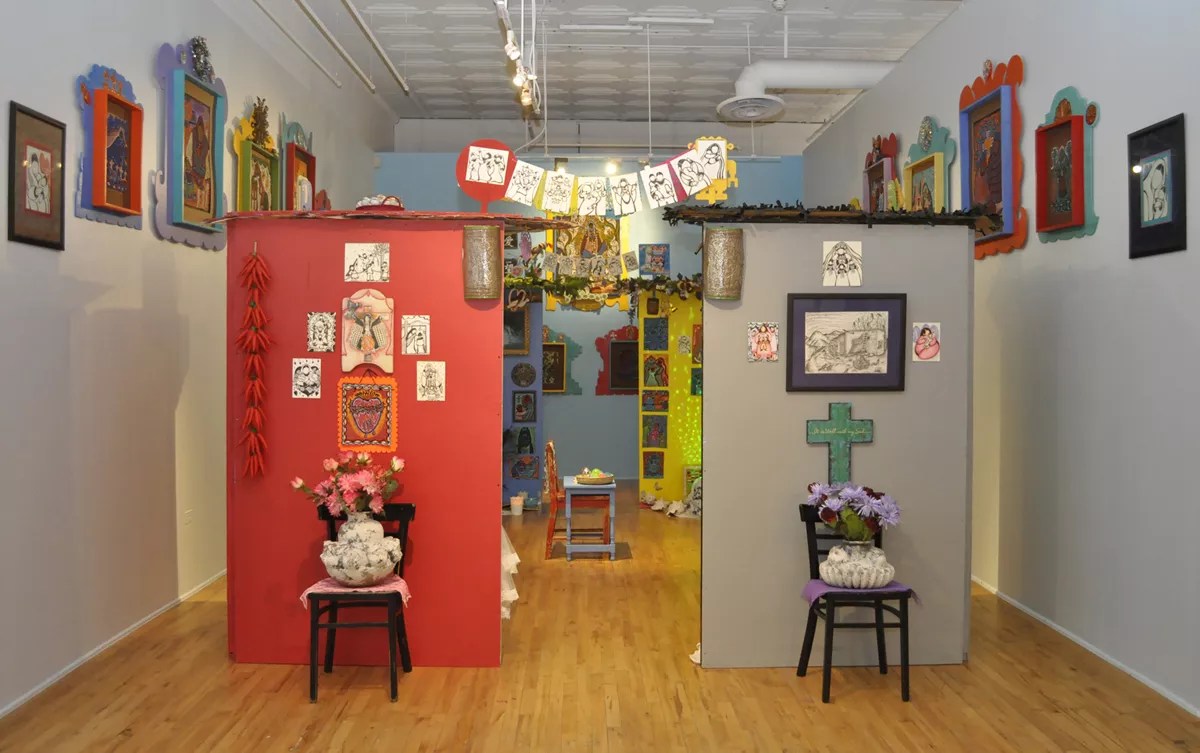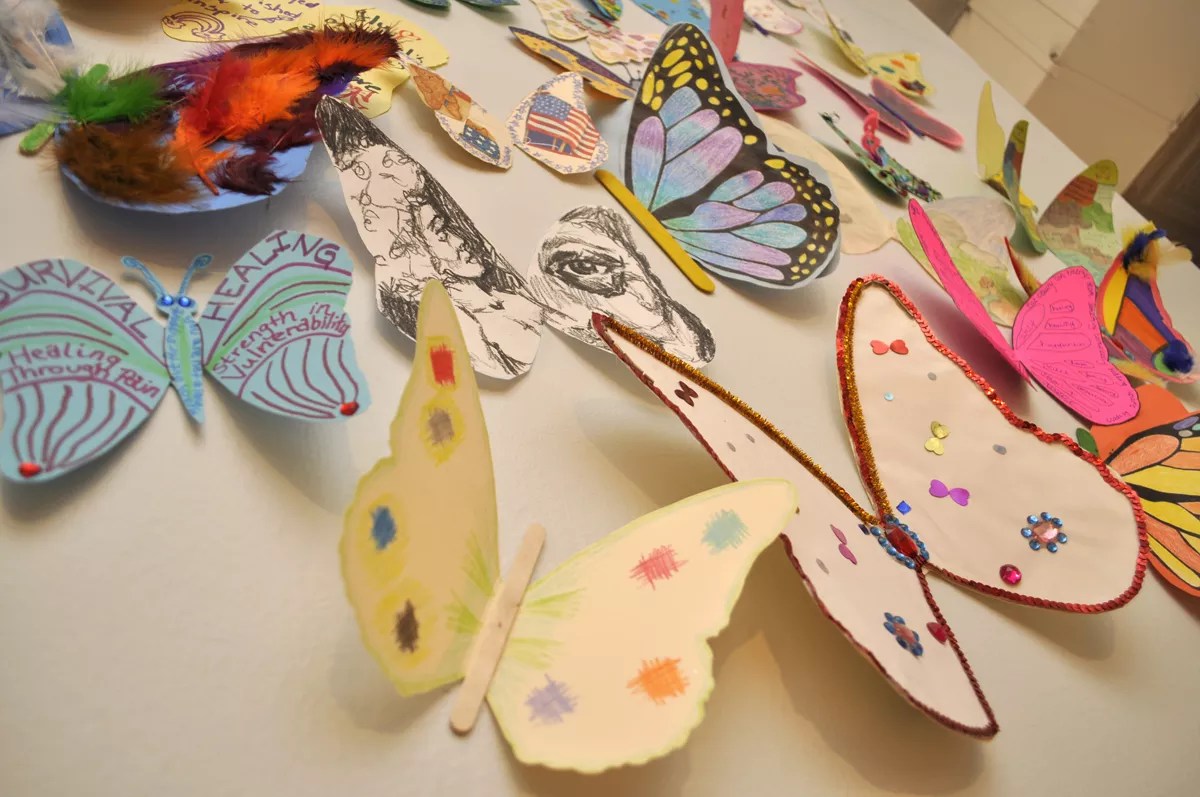
Victoria Paige Gonzalez

Audio By Carbonatix
Curators, scholars and artists around the world have been addressing the well-established pattern of discrimination against women in the visual arts, which has traditionally been a male-dominated enterprise. The result has been a cornucopia of exhibits meant to right those wrongs, and the Mile High City has been a particular beneficiary. A case in point is Las (H)adas at the Museo de las Americas, where Maruca Salazar kills two birds with one stone: Not only are the majority of the artists involved with the show women, but all of the artists included are Latino, another group that has seen discrimination in the art world – which, come to think of it, is why the Museo was founded in the first place.
The parenthetical “H” in the title gives the exhibit two meanings. Without the “H,” Salazar explains, “adas” is a Spanish suffix used to make a word feminine. With the “H,” it means “fairies.” “These women are the fairy godmothers of Latina art in Colorado,” she says. In curating the show, Salazar chose five artists – one of them deceased – and dedicated a large, discrete space to the work of each. In addition to the efforts of these fairy godmothers, Las (H)adas also has two more or less freestanding components, both dealing with violence against women. The exhibit starts off with one of these.

“Kaleidoscope Project,” Colorado Coalition Against Domestic Violence.
Courtesy Museo de las Americas
Salazar invited the Colorado Coalition Against Domestic Violence to participate, giving the group complete freedom in how it would do so. The coalition responded with “Kaleidoscope Project,” for which hundreds of anonymous women in domestic-violence programs across the state made butterflies – symbols of transformation – out of paper, decorating them with markers, crayons or glitter. Although the individual efforts have an expected amateur quality, the 2,000 pieces brought together for “Kaleidoscope Project” make a big statement. It’s punctuated with a somber finale, a grouping of blank, white-paper butterflies representing the women who have been killed in incidents of domestic violence so far this year in Colorado. There is also an audio component accessed via headsets, in which various women tell their perilous stories.
Will you step up to support Westword this year?
At Westword, we’re small and scrappy — and we make the most of every dollar from our supporters. Right now, we’re $23,250 away from reaching our December 31 goal of $50,000. If you’ve ever learned something new, stayed informed, or felt more connected because of Westword, now’s the time to give back.

“#NiUnaMas,” Museo staffers Josiah Lopez and Daniel Salazar, mixed media and video.
Courtesy Museo de las Americas
The second separate component is “#NiUnaMas,” dedicated to the many women who disappear annually in Juárez, Mexico, as a result of the drug wars in that country. For this installation, the walls of the gallery have been painted hot pink with an all-over pattern of dark crosses, so that the space resembles something like a cross between a chapel and a powder room. The back wall has a collage of photos taken from the web of the scores of missing women. Along the floor against the walls are rows of battery-powered votive lights, and in the middle of the space is an altar set with artificial flowers. Nearby, a video shows a printout set against color fields of the words of women describing the situation, while an audio component conveys the recitation of the “Hail Mary” in English, Spanish and Quechua, the indigenous language of the area around Juárez. The installation was created by the Museo’s staff; the painted walls are the work of Josiah Lopez, and the video is by Daniel Salazar. “#YoSoyGuadalupe,” by Judy Miranda, mixed media. Courtesy Museo de las Americas
Judy Miranda, the first of the fairy godmothers, has a career that stretches back thirty years. Her piece, “#YoSoyGuadalupe” (“I am Guadalupe”) is a large three-part screen placed between the chapel and “Kaleidoscope Project,” and it overlaps with some of the butterflies. The three panels each depict an arched doorway; in the center one, a figure with outstretched arms is wearing a robe bearing the apparition of Our Lady of Guadalupe. The figure’s face has been cut out so that viewers can go behind the screen, put their heads through the hole and have friends snap a photo, as at an old-timey carnival booth; they’re encouraged to post the resulting images on social media using the hashtag “#YoSoyGuadalupe.” The piece is an interesting conflation consistent with the kind of work that Miranda has done for many years, combining arguably the best-known symbol of Mexican culture and the idea of a festival, then wrapping them up with a tip of the hat to Facebook and Twitter.
Conceptual takes on Latina issues are also seen in Meggan DeAnza’s over-the-top multi-part installation “The Four Casitas.” The four – “Love,” “Violence,” “Transformation” and “Peace” – are meant to represent experiences encountered along the road of life. They deal with the notions of shelter and home as the place where the heart is – in this case, a woman’s heart. DeAnza is known for her santos, and she paints both traditional versions and contemporary reinterpretations of these classic portraits of the Catholic saints. For “The Four Casitas,” she has built four little sheds, called favelas, and filled them with her santo paintings as well as a wide range of found and ready-made items, from religious statuettes to an LCD monitor. DeAnza’s aggregational approach is often seen in Chicano art, but it’s rarely so fleshed out. You could spend a lot of time looking at this piece.

“Tree of Life,” by Arlette Lucero, acrylic paint.
Courtesy Museo de las Americas
Salazar has included a selection of beautiful, intriguingly designed felt dolls by Jessica Luna, a pioneering Latina activist who died young, in the early 1980s. Many of these soft sculptures seem to be responding to modernist figuration, as in “Going Crazy,” a bust of a woman whose face is a riot of colored needlework, her features merely lines across it. The dolls are extremely charming and demonstrate that Luna, who only began making them after she was diagnosed with cancer, had definitely developed a distinct approach to figuration. Opposite the Luna sculptures is Arlette Lucero’s “Tree of Life,” a mural whose figural subject matter is also rendered in a conventionalized way. In the center of the painting is the tree of the title, with a candelabra set with talismans floating in front of it; below the tree is the earth and sea, above it the mountains and sky. Off to the right is a kneeling woman who is magical, and in that way references the earth worship of Native Americans. “Images of Women,” by Jessica Luna, soft-sculpture dolls. Courtesy Museo de las Americas
The final phase of Las (H)adas is “La Á‘usta de la Laguna Huaypo,” an installation by Ana María Hernando comprising a sculpture combined with wall panels. “La Á‘usta” is the mountain spirit recognized by the Andean people of Peru, a country that Hernando has visited repeatedly. Using petticoats crocheted by village women in the Andes, Hernando builds a form that is both woman and mountain, with the skirts laid one over the other to achieve the desired height. On the walls are arrangements of gossamer-thin bits of cut cloth adorned with decorations embroidered by cloistered nuns in Argentina, Hernando’s native country. The result is a strong statement that’s very delicately detailed at the same time. “La Courtesy Museo de las Americas
In September, Salazar announced that she was stepping down as director of the Museo, handing over the job to Claudia Moran, who has worked there in various capacities for the past several years. But Salazar will continue as the Museo’s curator through at least 2018, so happily, Las (H)adas is not her swan song. Even so, it’s a signature Salazar presentation, with local artists – in particular, those who are part of the Latino community – justly given the spotlight.
Las (H)adas, through January 13 at the Museo de las Americas, 861 Santa Fe Drive, 303-571-4401, museo.org.